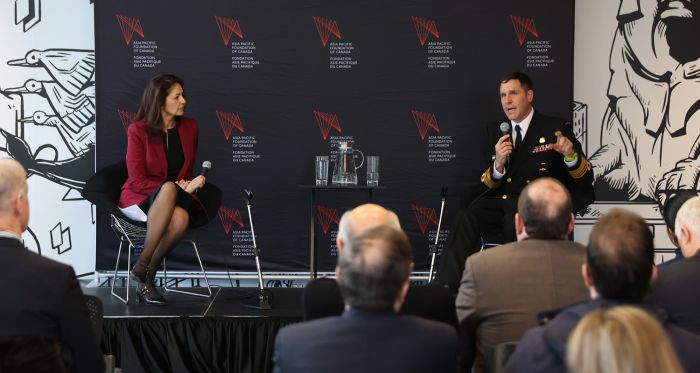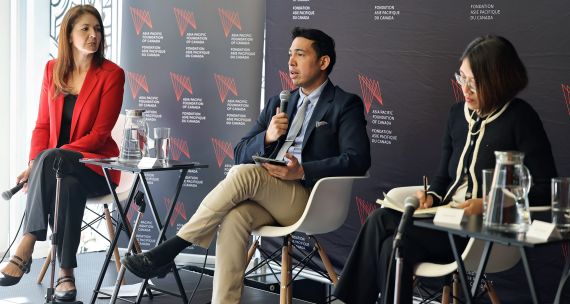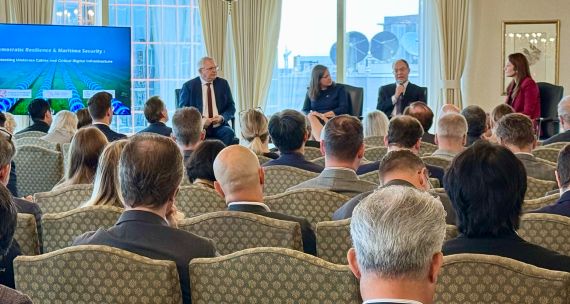Le 3 février 2025, la FAP Canada a eu l’honneur d’accueillir le vice-amiral Angus Topshee, le 38e commandant de la Marine royale canadienne, pour une discussion sur certaines difficultés maritimes et certains impératifs stratégiques critiques qui se présenteront au Canada au 21e siècle. Après quelques mots d’introduction, le vice-amiral a entamé la conversation avec Vina Nadjibulla, vice-présidente Recherche et stratégie de la FAP Canada, avant de répondre aux questions du public. Les points importants de la discussion sont résumés ci-dessous.
Le vice-amiral Topshee a réitéré l’importance capitale de maintenir un ordre international solide et fondé sur des règles pour la sécurité et la prospérité du Canada. Cet ordre fondé sur des règles a joué un rôle critique pour élever le niveau de vie mondial en permettant le commerce, qui est principalement effectué par transport maritime.
Pour faire respecter cet ordre fondé sur des règles, la Marine canadienne est désormais déployée mondialement, y compris dans l’Indo-Pacifique. Dans le passé, la présence de corps de défense du Canada dans cette région a manqué de cohérence, mais la stratégie pour l’Indo-Pacifique a permis de mobiliser des ressources, permettant à Ottawa d’avoir un navire canadien présent en permanence dans la région indo-pacifique. Cette nouvelle approche cohérente permet non seulement au Canada de suivre les développements importants dans l’espace maritime, mais démontre également que le Canada est aussi une nation du Pacifique.
Néanmoins, le vice-amiral a reconnu l’existence d’enjeux sérieux quant aux lacunes de la capacité physique de l’armée canadienne. Le Pacifique est un vaste océan, et la région indo-pacifique requiert des navires de combat. Le Canada ne compte que 12 frégates, qui ont toutes été mises en service pour une durée de vie de 30 ans entre 1992 et 1996, mais qui doivent rester opérationnelles le temps qu’Ottawa achève la construction de nouveaux navires, qui ne seront vraisemblablement pas prêts avant le début des années 2030 au plus tôt.
Mme Nadjibulla a fait allusion à un récent article de The Economist selon lequel la Chine produit désormais 50 % de tous les navires, et ce, à un rythme rapide. Elle a demandé quelle pourrait être la contribution du Canada, d’autant plus que, pour le Canada, un déploiement dans le Pacifique nécessite beaucoup plus de ressources et de capacités que pour un déploiement dans l’Atlantique. Le vice-amiral a ajouté que même les États-Unis ne parviennent pas à bâtir des navires à un rythme suffisant. Le Canada, pendant ce temps, investit avec précision et grande réflexion, mais rencontre de sérieux enjeux d’échelle.
Une partie des nouveaux navires canadiens devront, bien entendu, être réservés à l’Arctique. Même si le passage du Nord-Ouest n’est pas susceptible de devenir une route commerciale viable, même avec le réchauffement des températures, la zone deviendra plus accessible et suscitera un intérêt croissant auprès des acteurs étrangers, notamment la Chine, pour les ressources minérales et les stocks de poissons. Le vice-amiral Topshee explique que, d’un point de vue juridique, cela ne constitue pas nécessairement une menace à la souveraineté canadienne. Même si le Canada perd l’argument selon lequel le passage du Nord-Ouest est un détroit international, l’article 234 de la Convention des Nations Unies sur le droit de la mer donne au Canada le droit de réglementer la circulation dans cette zone.
De manière plus préoccupante, une zone de haute mer située au-delà de la limite de 200 milles nautiques pourrait ainsi devenir un site de concurrence internationale. À mesure que les températures augmentent, les poissons migrent vers le nord, et les flottes de pêche suivront. Même s’il existe actuellement un moratoire sur la pêche dans ces régions, il pourrait être levé. De plus, les pays des nations du Sud, dont plusieurs ont des préoccupations en matière de sécurité alimentaire, demanderont certainement pourquoi seuls les pays arctiques auraient un accès exclusif à ces ressources.
Dans cette optique, il est pertinent de surveiller les actions de la Chine. Le vice-amiral a souligné que chaque fois qu’un navire chinois entre dans les eaux canadiennes, il se conforme à l’obligation légale d’en demander la permission. Cependant, d’autres motifs pourraient expliquer ce comportement : peut-être que Beijing tente d’établir un précédent pour obliger les autres pays à demander la permission de la Chine pour entrer dans « ses » eaux, y compris la mer de Chine méridionale. Comme l’a souligné le vice-amiral Topshee, le Canada n’est pas nécessairement d’accord avec la façon dont Beijing interprète les « règles » régissant cette région.
Un autre défi réside dans le fait que, même si la marine canadienne observe des changements dans les capacités matérielles des autres pays, il est beaucoup plus difficile de comprendre les intentions. Par exemple, l’armée chinoise a entrepris un renforcement massif en temps de paix, dont l’objectif demeure obscur. Jusqu’à présent, les indicateurs semblent aller dans des directions différentes. D’une part, les actions coercitives de la Chine autour du récif Second Thomas, dans la mer des Philippines occidentales, sont troublantes, tout comme son agression dans les eaux environnant Taïwan. D’autre part, la Chine a apporté une contribution positive grâce à sa mission de lutte contre la piraterie autour de la Corne de l’Afrique.
Le vice-amiral Topshee a mentionné que lors d’une réunion avec son homologue chinois en avril 2024, le Canada et la Chine ont évoqué des principes similaires, notamment l’importance de garder les mers accessibles pour que chacun puisse s’engager dans des activités commerciales. La divergence réside dans la façon dont les différentes parties interprètent ces principes. C’est pourquoi un dialogue régulier est si important et permet d’obtenir une meilleure idée de ce que nos homologues ont en tête.
Mme Nadjibulla a suggéré la nécessité pour le Canada de repenser fondamentalement sa politique étrangère, y compris nos hypothèses au sujet des États-Unis. Cette réflexion devrait se concentrer sur une stratégie mondiale générale, reconnaissant que le monde a évolué et que le Canada pourrait avoir besoin de développer de nouvelles capacités pour faire face à ces changements. Le vice-amiral a convenu que le Canada a besoin d’entretenir des discussions importantes sur ces sujets et tendances.





